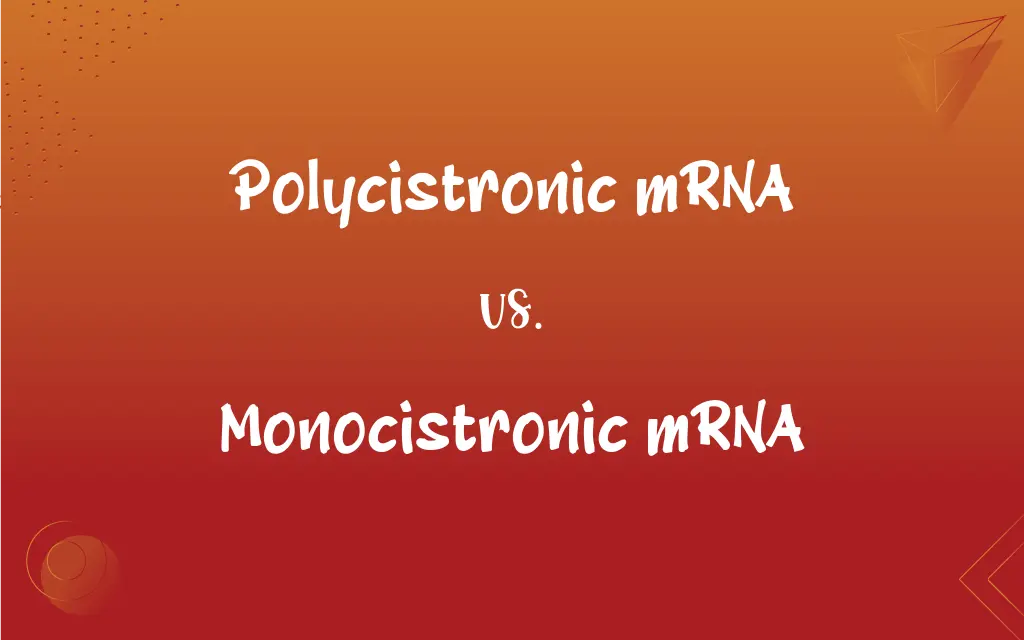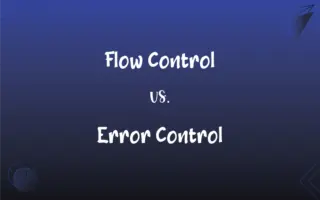Polycistronic mRNA vs. Monocistronic mRNA: What's the Difference?
Edited by Janet White || By Harlon Moss || Updated on October 5, 2023
Polycistronic mRNA contains multiple coding regions for different proteins, while monocistronic mRNA has a single coding region for one protein.

Key Differences
Polycistronic mRNA carries the genetic information for several protein-coding genes, meaning it can direct the synthesis of multiple proteins. Contrarily, monocistronic mRNA is structured to hold the information for the synthesis of just one protein, encompassing only a single coding region.
Polycistronic mRNA is prominent in prokaryotic organisms, facilitating the efficient, simultaneous production of a group of proteins. Monocistronic mRNA, predominantly found in eukaryotes, facilitates the translation of a single protein, ensuring discrete regulation and expression of eukaryotic genes.
Transcription of polycistronic mRNA yields a single transcript that encodes multiple proteins, often functioning in a related pathway. Conversely, the transcription of monocistronic mRNA produces a transcript that encodes a solitary protein, allowing for precise control over gene expression.
Research involving polycistronic mRNA can illuminate coordinated gene regulation in prokaryotes, as a single mRNA molecule governs the synthesis of multiple proteins. In contrast, monocistronic mRNA studies can highlight regulated, individual gene expression typically observed in eukaryotes.
Polycistronic mRNA enables the coupled expression of related genes, which is particularly beneficial for the coordinated production of protein complexes. In contrast, monocistronic mRNA allows for independent regulation of genes, which is vital for the nuanced, differential gene expression witnessed in eukaryotic organisms.
ADVERTISEMENT
Comparison Chart
Coding Regions
Multiple
Single
Organism Type
Primarily prokaryotes
Primarily eukaryotes
Gene Expression
Coordinated expression of genes
Independent expression of genes
Protein Synthesis
Produces multiple proteins from one mRNA molecule
Produces one protein from one mRNA molecule
Transcription Complexity
Relatively simple and straightforward
Can involve complex splicing and modification
ADVERTISEMENT
Polycistronic mRNA and Monocistronic mRNA Definitions
Polycistronic mRNA
In polycistronic mRNA, multiple start and stop codons delineate regions for different proteins.
Polycistronic mRNA allows for the sequential translation of multiple protein-coding regions within a singular mRNA molecule.
Monocistronic mRNA
Monocistronic mRNA is characteristic of eukaryotic organisms.
Eukaryotic genes, such as those in humans, typically produce monocistronic mRNA, each encoding a unique protein.
Polycistronic mRNA
Polycistronic mRNA is common in prokaryotic organisms.
Bacterial genes organized in operons often utilize polycistronic mRNA to regulate related genes collectively.
Monocistronic mRNA
The transcription of monocistronic mRNA involves splicing to remove introns.
The intricate splicing of monocistronic mRNA in eukaryotes allows for the excision of non-coding regions before translation.
Polycistronic mRNA
The presence of multiple cistrons enables polycistronic mRNA to encode multiple proteins.
Through the utilization of polycistronic mRNA, the genes in an operon are transcribed into a single mRNA molecule, facilitating the production of several proteins.
Monocistronic mRNA
Monocistronic mRNA features one coding region between its start and stop codons.
Each monocistronic mRNA corresponds to a single gene, directing the synthesis of a specific protein.
Polycistronic mRNA
Polycistronic mRNA encodes multiple proteins in one transcript.
The operons in E. coli often contain polycistronic mRNA, orchestrating the synthesis of several proteins from a single transcript.
Monocistronic mRNA
Monocistronic mRNA carries the genetic code for a single protein.
In humans, monocistronic mRNA ensures the translation of a single gene product per mRNA transcript.
Polycistronic mRNA
Polycistronic mRNA typically facilitates the coordinated expression of related genes.
The expression of genes within an operon via polycistronic mRNA ensures the synchronized production of proteins in a particular pathway.
Monocistronic mRNA
Monocistronic mRNA allows for independent, regulated expression of individual genes.
Monocistronic mRNA enables eukaryotic cells to selectively express genes, catering to specific cellular needs and conditions.
FAQs
Are eukaryotes associated with monocistronic or polycistronic mRNA?
Eukaryotes typically produce monocistronic mRNA, which codes for a single protein.
What does polycistronic mRNA encode for?
Polycistronic mRNA encodes for multiple proteins within a single mRNA transcript.
What is the significance of polycistronic mRNA in operons?
In operons, polycistronic mRNA allows for the coordinated expression of multiple genes involved in a common pathway.
Where is polycistronic mRNA typically found?
Polycistronic mRNA is commonly found in prokaryotic organisms, such as bacteria.
What are the start and stop codons in polycistronic mRNA?
Polycistronic mRNA has multiple start and stop codons, each delineating different coding regions for proteins.
Can an organism have both polycistronic and monocistronic mRNA?
Yes, some organisms, particularly certain unicellular eukaryotes, might exhibit both types of mRNA.
How does polycistronic mRNA affect the efficiency of protein synthesis in prokaryotes?
Polycistronic mRNA enhances the efficiency by allowing simultaneous synthesis of multiple proteins from a single mRNA molecule.
What is an example of a polycistronic mRNA in bacteria?
The lac operon in E. coli is an example of polycistronic mRNA, controlling genes related to lactose metabolism.
Does monocistronic mRNA involve complex transcriptional processes?
Yes, monocistronic mRNA in eukaryotes often involves complex processes like splicing.
Is it possible for eukaryotic cells to have polycistronic mRNA?
While it's common in prokaryotes, certain eukaryotic cells (typically in unicellular eukaryotes) can also exhibit polycistronic mRNA.
How is translation affected by polycistronic mRNA?
Translation of polycistronic mRNA produces several protein products from a single mRNA molecule.
In what cellular processes is monocistronic mRNA pivotal?
Monocistronic mRNA is pivotal in eukaryotic cellular processes that require precise, individual gene regulation.
How is the expression of genes in polycistronic mRNA regulated?
In polycistronic mRNA, gene expression is often collectively regulated, with one promoter controlling the transcription of multiple genes.
Are introns present in monocistronic mRNA?
In eukaryotic monocistronic mRNA, introns are typically present and are removed during mRNA processing (splicing).
How does monocistronic mRNA contribute to differential gene expression?
Monocistronic mRNA allows for the distinct and independent expression of individual genes, facilitating differential gene expression.
What role does polycistronic mRNA play in metabolic pathways in prokaryotes?
Polycistronic mRNA often encodes proteins involved in a single metabolic pathway, ensuring coordinated expression.
How does monocistronic mRNA regulate gene expression?
Monocistronic mRNA allows for the independent regulation and expression of a single gene.
Can monocistronic mRNA be found in prokaryotic organisms?
Yes, while less common, some prokaryotic genes are expressed via monocistronic mRNA.
Does monocistronic mRNA feature multiple start and stop codons?
No, monocistronic mRNA typically contains a single start and stop codon, framing one coding region.
Can monocistronic mRNA code for multiple proteins?
No, monocistronic mRNA codes for a single protein.
About Author
Written by
Harlon MossHarlon is a seasoned quality moderator and accomplished content writer for Difference Wiki. An alumnus of the prestigious University of California, he earned his degree in Computer Science. Leveraging his academic background, Harlon brings a meticulous and informed perspective to his work, ensuring content accuracy and excellence.
Edited by
Janet WhiteJanet White has been an esteemed writer and blogger for Difference Wiki. Holding a Master's degree in Science and Medical Journalism from the prestigious Boston University, she has consistently demonstrated her expertise and passion for her field. When she's not immersed in her work, Janet relishes her time exercising, delving into a good book, and cherishing moments with friends and family.































































